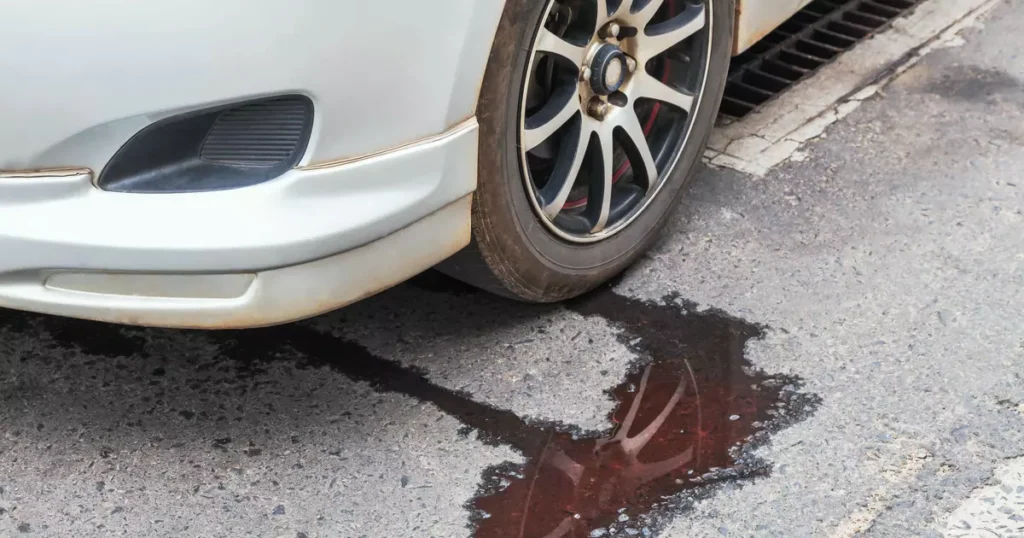1. Why Cars Drip Clear Fluid — The Most Common Explanations
When you see a transparent, odorless droplet or puddle under your car, the first instinct is alarm. But in my experience, the especially in warm, humid environments.
As your air conditioner removes moisture from cabin air, that water must go somewhere. It drains out through a condensate drain tube, often dripping underneath the car. That’s normal and expected when the A/C has been running. Many repair guides and service sites confirm this is the default assumption for clear fluid leaks.
However, that should not be your only assumption. Certain critical systems use especially in older systems or diluted states (e.g. brake fluid). Missing a diagnosis can risk safety.
Thus, we proceed with caution, systematically diagnosing.
2. 7 Possible Causes of Clear Fluid Leaks
Below are the top suspects for a clear fluid leak. I list them from most benign to most risky, with signs, how to test, and what to do.
1. A/C Condensation / Evaporator Drain
Why / when it happens:
- After running the air conditioning, moisture in cabin air condenses and is expelled via a drain tube.
- On hot days, this drip is heavier.
Signs it’s this cause:
- Leak only appears when A/C has been in use.
- The fluid is cold, odorless, and pure water.
- The drip is usually near the center / front underside of car (below evaporator area).
What to check/test:
- Run A/C for 5 minutes, then park and wait — see if droplet forms.
- Use a paper sheet or cardboard under the expected drain tube location to catch drips.
- Inspect the drain tube for blockage (e.g. from dirt, leaves).
What to do:
- If confirmed, no repair needed beyond clearing the tube if clogged.
2. Rainwater / Wash Water Entrapment
Why / when it happens:
- After cleaning or rain, water may be trapped in door sills, drip rails, or body panels and slowly drain out.
Signs:
- Starts shortly after rain / car wash.
- Appears near wheel arches, sill area, or under doors.
Test:
- Check if leak appears immediately after external water exposure.
- Feel whether drip comes from body seams or drains, not from mechanical systems.
Action:
- Let it drain naturally; ensure drain holes (in door sills, wheel wells) are clear.
3. Clear Brake Fluid Leak
Why it can appear clear:
- Fresh brake fluid (especially DOT 3 or DOT 4) can be very light or amber but sometimes nearly transparent.
- In rare cases, diluted or aged fluid may look almost clear.
Danger level: High — because brake fluid is vital for stopping.
Signs:
- Brake pedal feels spongy or goes low (loses firmness) when pressed.
- The leak is located near wheels, brake lines, calipers, or master cylinder.
- The fluid feels oily (not pure water) to touch.
Test:
- Wipe the fluid — does it feel slippery or oily?
- Open the brake fluid reservoir — see if level is falling.
- Avoid driving if you suspect this — your stopping ability is compromised.
What to do:
- Immediately get professional inspection and repair.
- Do not ignore — driving with brake fluid loss is dangerous.
4. Coolant Leak (Rarely Clear)
Why might it appear clear:
- Some modern antifreeze/coolant formulations are very pale or colorless (especially when diluted).
- If a leak is very fresh or mixed with water, it might appear translucent.
Signs:
- Overheating engine, low coolant reservoir, engine warning lights.
- The drip feels slippery and may have a slight sweet smell.
- Leak tends to originate from radiator area, hoses, or the cylinder head/gasket.
Test:
- Inspect coolant reservoir and see if it is low.
- Use infrared thermometer to detect temperature anomalies around suspected leak spot.
What to do:
- Repair the leak (hose, gasket, clamp) promptly — running low coolant can lead to engine damage.

5. Windshield Washer Fluid (Clear Variant)
Why:
- Some washer fluids (especially diluted versions) may appear nearly clear.
Signs:
- Occurs near the front of car, under the windshield washer tank or pumps.
- The fluid may smell soapy or alcohol-like.
Test:
- Inspect washer tank and lines for cracks.
- Fill with known colored washer fluid and see if the leak changes.
Fix:
- Replace cracked tubing or seal, tighten clamps, or replace the reservoir.
6. Leak from EV / Hybrid Cooling / Thermal Systems
Context:
- EVs or hybrids often have coolant loops or thermal battery systems.
- Some of these fluids can be colorless or light.
Signs:
- Leak when vehicle is off or under thermal load.
- System diagnostics show thermal errors or cooling warnings.
Test / Action:
- Use the vehicle’s diagnostic system to monitor coolant levels.
- If suspicion arises, refer to manufacturer’s service guidelines.
7. Miscellaneous: Fuel, Gear Oil, etc.
While most other fluids are colored or odorous, sometimes unusual conditions can make them appear nearly clear.
Examples / clues:
- Very light petroleum fuel vapors or gasoline (rarely truly clear).
- Gear oil in differential that is very lightly colored.
Test / Action:
- Smell test (fuel has strong odor).
- Check fluid levels in suspected systems.
8. Frequently Asked Questions
Q: Can clear fluid leak ever be engine oil?
A: Unlikely — engine oil is viscous and darker. If it’s extremely fresh or mixed with water, the top layer might look lighter, but you’ll usually see oily sheen or discoloration.
Q: Why did the leaking stop when I turned off the car?
A: Probably because the leak was tied to active systems (like A/C condensate) which aren’t engaged when car is idle.
Q: My car is old; can brake fluid look clear?
A: With age and dilution, it may lighten, but a “clear” leak is rarely brake fluid unless a rare fault is in play. Always test feel/viscosity.
Q: I have a hybrid — could battery cooling leak be clear?
A: Yes. Some battery thermal systems use coolant or refrigerant loops whose fluids may appear light. Use the vehicle’s diagnostic readouts to monito
